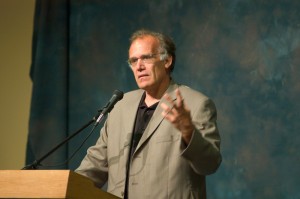
Frank Lloyd Wright
Presented with the kind permission of Ken Burns.
From promotional blurb:
Frank Lloyd Wright was the greatest of all American architects. He was an authentic American genius, a man who believed he was destined to redesign the world, creating everything anew.
Over the course of his long career, Wright designed over eight hundred buildings, including such revolutionary structures as the Guggenheim Museum, the Johnson Wax Building, Fallingwater, Unity Temple and Taliesin.
Wright’s buildings and his ideas changed the way we live, work and see the world around us. Frank Lloyd Wright’s architectural achievements were often overshadowed by the turbulence of his melodramatic life.
In ninety-two years, he fathered seven children, married three times and was almost constantly embroiled in scandal. Some hated him, some loved him, but in the end, few could deny that he was the most important architect in America – and perhaps the world.
With exquisite live cinematography, fascinating interviews and rare archival footage, this riveting film (by Ken Burns and Lynn Novick) brings Wright’s unforgettable story to life.
John Clark @ Amazon.com …
The beauty of (this documentary) Frank Lloyd Wright is that aside from telling a long and often melodramatic story lucidly, it deals with issues of art and architecture in ways that are approachable but not simplistic. (It’s also surprisingly scandalous, although this is seen as part of his art.)
Wright was first and foremost a rebel who took his cues from nature, though, as one commentator points out, this is not to say his approach was natural. What he was rebelling against was the clutter and claustrophobia of Victorian architecture. The rooms he designed opened up on each other, and his exteriors seemed to grow laterally out of the landscape.
… The filmmakers have wisely kept the technical talk to a minimum, but they are also not afraid to step back and let the experts ruminate on the nature of his genius, even when these experts are at a loss for words.
… Wright himself comes across as a man who never doubted himself, a lousy father, and self-consciously Byronic. His vitality and larger-than-life persona seemed to belong to the 19th century, making him–and this is perhaps a mixed blessing — the last of his kind.

Falling Water


